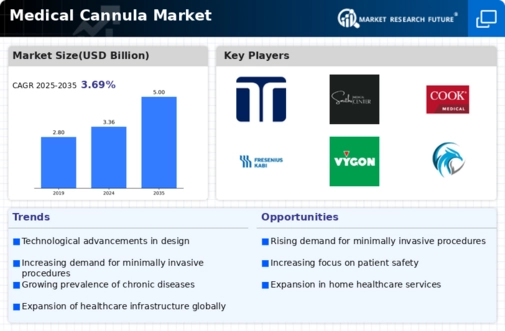Market Trends and Projections
Growth in Healthcare Expenditure
An increase in global healthcare expenditure significantly contributes to the expansion of the Global Medical Cannula Market Industry. Governments and private sectors are investing more in healthcare infrastructure, leading to improved access to medical devices, including cannulas. This investment is particularly evident in emerging economies, where healthcare systems are rapidly evolving. Enhanced funding allows for the procurement of advanced medical technologies, thereby increasing the availability of high-quality cannulas. As healthcare spending continues to rise, the market is poised for sustained growth, reflecting the ongoing commitment to improving patient care.
Regulatory Support for Medical Devices
The Global Medical Cannula Market Industry benefits from supportive regulatory frameworks that facilitate the approval and commercialization of innovative medical devices. Regulatory bodies are increasingly streamlining the approval processes for cannulas, ensuring that safe and effective products reach the market more quickly. This regulatory support encourages manufacturers to invest in research and development, fostering innovation in cannula technology. As a result, the market is likely to see a proliferation of new products that meet evolving healthcare needs, further driving growth and enhancing patient outcomes.
Increasing Prevalence of Chronic Diseases
The Global Medical Cannula Market Industry is influenced by the rising prevalence of chronic diseases, such as diabetes and cardiovascular disorders, which necessitate frequent medical interventions. Cannulas are essential for administering medications, fluids, and blood products in patients with these conditions. As the global population ages and the incidence of chronic diseases escalates, the demand for cannulas is expected to rise. This trend underscores the importance of cannulas in managing long-term health issues, thereby propelling market growth and ensuring that healthcare systems can meet the increasing needs of patients.
Technological Advancements in Cannula Design
Innovations in cannula design significantly impact the Global Medical Cannula Market Industry, as manufacturers develop products that enhance patient safety and procedural efficiency. Recent advancements include the introduction of smart cannulas equipped with sensors that monitor vital signs during procedures. These innovations not only improve patient outcomes but also reduce the likelihood of complications. As a result, the market is expected to grow at a CAGR of 3.68% from 2025 to 2035, reaching an estimated value of 5 USD Billion by 2035, reflecting the industry's responsiveness to technological progress.
Rising Demand for Minimally Invasive Procedures
The Global Medical Cannula Market Industry experiences a surge in demand for minimally invasive procedures, which are increasingly preferred due to their reduced recovery times and lower risk of complications. Cannulas play a crucial role in these procedures, facilitating efficient access to veins and other tissues. As healthcare providers adopt these techniques, the market is projected to reach 3.36 USD Billion in 2024. This trend is likely to continue, as advancements in technology enhance the efficacy and safety of cannulas, thereby driving further growth in the industry.













